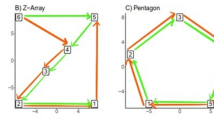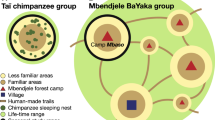Abstract
Rat exploration is an organized series of trips. Each exploratory trip involves an outward tour from the refuge followed by a return to the refuge. A tour consists of a sequence of progressions with variable direction and speed concatenated by stops, whereas the return consists of a single direct progression. We have argued that processing self-movement information generated on the tour allows a rat to plot the return to the refuge. This claim has been supported by observing consistent differences between tour and return segments independent of ambient cue availability; however, this distinction was based on differences in movement characteristics derived from multiple progressions and stops on the tour and the single progression on the return. The present study examines movement characteristics of the tour and return progressions under novel-dark and light conditions. Three novel characteristics of progressions were identified: (1) linear speeds and path curvature of exploratory trips are negatively correlated, (2) tour progression maximum linear speed and temporal pacing varies as a function of travel distance, and (3) return progression movement characteristics are qualitatively different from tour progressions of comparable length. These observations support a role for dead reckoning in organizing exploratory behavior.












Similar content being viewed by others
References
Barlow JS (1964) Inertial navigation as a basis for animal navigation. J Theor Biol 6:76–117
Benhanou S, Sauvé JP, Bovet P (1990) Spatial memory in large scale movements: Efficiency and limitations of the egocentric coding processes. J Theor Biol 145:1–12
Biegler R (2000) Possible uses of path integration in animal navigation. Anim Learn Behav 28(3):257–277
Biegler R, Morris RGM (1996) Landmark stability: further studies pointing to a role in spatial learning. Q J Exp Psychol B 49(4):307–345
Binet A, Courtier J (1893) Sur la vitesse des gestes graphiques [On the speed of graphic movements]. Rev Philos 35:664–671
Darwin C (1873) Origin of certain insects. Nature 7:417–418
de’Sperati C, Viviani P (1997) The relationship between curvature and velocity in two-dimensional smooth pursuit eye movements. J Neurosci 17(10):3932–3945
Drai D, Golani I (2001) SEE: a tool for the visualization and analysis of rodent exploratory behavior. Neurosci Biobehav Rev 25(5):409–426
Drai D, Benjamini Y, Golani I (2000) Statistical discrimination of natural modes of motion in rat exploratory behavior. J Neurosci Methods 96(2):119–131
Eilam D (2003). Open-field behavior withstands drastic changes in arena size. Behav Brain Res 142(1–2):53–62
Eilam D, Golani I (1989) Home base behavior of rats (Rattus norvegicus) exploring a novel environment. Behav Brain Res 34(3):199–211
Eilam D, Dank M, Maurer R (2003) Voles scale locomotion to the size of the open-field by adjusting the distance between stops: a possible link to path integration. Behav Brain Res 141(1):73–81
Etienne AS, Jeffery KJ (2004) Path integration in mammals. Hippocampus 14:180–192
Etienne AS, Maurer R, Saucy F, Teroni E (1986) Short distance homing in the golden hamster after a passive outward journey. Anim Behav 34:696–715
Etienne AS, Boulens V, Maurer R, Rowe T, Siegrist C (2000) A brief view of known landmarks reorientates path integration in hamsters. Naturwissenschaften 87:494–498
Gallistel CR (1990) The organization of learning. MIT Press, Cambridge, MA
Gharbawie OA, Whishaw PA, Whishaw IQ (2004) The topography of three-dimensional exploration: a new quantification of vertical and horizontal exploration, postural support, and exploratory bouts in the cylinder test. Behav Brain Res 151(1–2):125–135
Golani I, Benjamini Y, Eilam D (1993) Stopping behavior: constraints on exploration in rats (Rattus norvegicus). Behav Brain Res 53(1–2):21–33
Gordon J, Ghilardi MF, Cooper SE, Ghez C (1994) Accuracy of planar reaching movements. II. Systematic extent errors resulting from inertial anisotropy. Exp Brain Res 99:112–130
Hamilton DA, Rosenfelt CS, Whishaw IQ (2004) Sequential control of navigation by locale and taxon cues in the Morris water task. Behav Brain Res 154(2):385–397
Hines DJ, Whishaw IQ (2005) Home bases formed to visual cues but not to self-movement (dead reckoning) cues in exploring hippocampectomized rats. Eur J Neurosci 22(9):2363–2375
Krebs HI, Aisen ML, Volpe BT, Hogan N (1999) Quantization of continuous arm movements in humans with brain injury. Proc Natl Acad Sci USA 96(8):4645–4649
Lacquaniti F, Terzuolo C, Viviani P (1983) The law relating the kinematic and figural aspects of drawing movements. Acta Psychol (Amst) 54(1–3):115–130
Maaswinkel H, Whishaw IQ (1999) Homing with locale, taxon, and dead reckoning strategies by foraging rats: sensory hierarchy in spatial navigation. Behav Brain Res 99(2):143–152
Mittelstaedt ML, Mittelstaedt H (1980) Homing by path integration in a mammal. Naturwissenschaften 67:566–567
Mittelstaedt ML, Mittelstaedt H (2001) Homing by path integration in a mammal. Naturwissenschaften 67:566–567
Murphy JJ (1873) Instinct: a mechanical analogy. Nature 7:483
Neitz J, Jacobs GH (1986) Reexamination of spectral mechanisms in the rat (Rattus norvegicus). J Comp Psychol 100(1):21–29
Séguinot V, Maurer R, Etienne AS (1993) Dead reckoning in a small mammal: the evaluation of distance. J Comp Physiol [A] 173:103–113
Sternad D, Schaal S (1999) Segmentation of endpoint trajectories does not imply segmented control. Exp Brain Res 124(1):118–136
Tchernichovski O, Benjamini Y, Golani I (1998) The dynamics of long-term exploration in the rat. Part I. A phase-plane analysis of the relationship between location and velocity. Biol Cybern 78(6):423–432
Vieilledent S, Kerlirzin Y, Dalbera S, Berthoz A (2001) Relationship between velocity and curvature of a human locomotor trajectory. Neurosci Lett 305(1):65–69
Viviani P, Flash T (1995) Minimum-jerk, two-thirds power law, and isochrony: converging approaches to movement planning. J Exp Psychol Hum Percept Perform 21(1):32–53
Viviani P, Schneider R (1991) A developmental study of the relationship between geometry and kinematics in drawing movements. J Exp Psychol Hum Percept Perform 17(1):198–218
Wallace DG, Whishaw IQ (2003) NMDA lesions of Ammon's horn and the dentate gyrus disrupt the direct and temporally paced homing displayed by rats exploring a novel environment: evidence for a role of the hippocampus in dead reckoning. Eur J Neurosci 18(3):513–523
Wallace DG, Hines DJ, Pellis SM, Whishaw IQ (2002a) Vestibular information is required for dead reckoning in the rat. J Neurosci 22(22):10009–10017
Wallace DG, Hines DJ, Whishaw IQ (2002b) Quantification of a single exploratory trip reveals hippocampal formation mediated dead reckoning. J Neurosci Methods 113(2):131–145
Wallace DG, Choudhry S, Martin MM (in press) Comparative analysis of dead reckoning based navigation in humans (Homo sapiens) and rats (Rattus norvegicus). J Comp Psychol
Whishaw IQ, Mittleman G (1986) Visits to starts, routes, and places by rats (Rattus norvegicus) in swimming pool navigation tasks. J Comp Psychol 100(4):422–431
Whishaw IQ, Kolb B, Sutherland RJ (1983) The analysis of behavior in the laboratory rat. In: Robinson TE (ed) Behavioral approaches to brain research. Oxford University Press, New York, pp 141–211
Acknowledgements
This research was supported by grants from Alberta Heritage Foundation for Medical Research and the Canadian Institute of Health Research. All experimental procedures in this study were approved by the University of Lethbridge Animal Care Committee, which follows the standards set by the Canadian Council on Animal Care. The authors would like to acknowledge the comments of Patricia Wallace on previous drafts of the paper. We would also like to thank Felicia Drever, Irene Loewen, and Logan Bennett for data collection and analysis related to this project.
Author information
Authors and Affiliations
Corresponding author
Rights and permissions
About this article
Cite this article
Wallace, D.G., Hamilton, D.A. & Whishaw, I.Q. Movement characteristics support a role for dead reckoning in organizing exploratory behavior. Anim Cogn 9, 219–228 (2006). https://doi.org/10.1007/s10071-006-0023-x
Received:
Revised:
Accepted:
Published:
Issue Date:
DOI: https://doi.org/10.1007/s10071-006-0023-x




